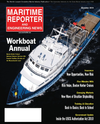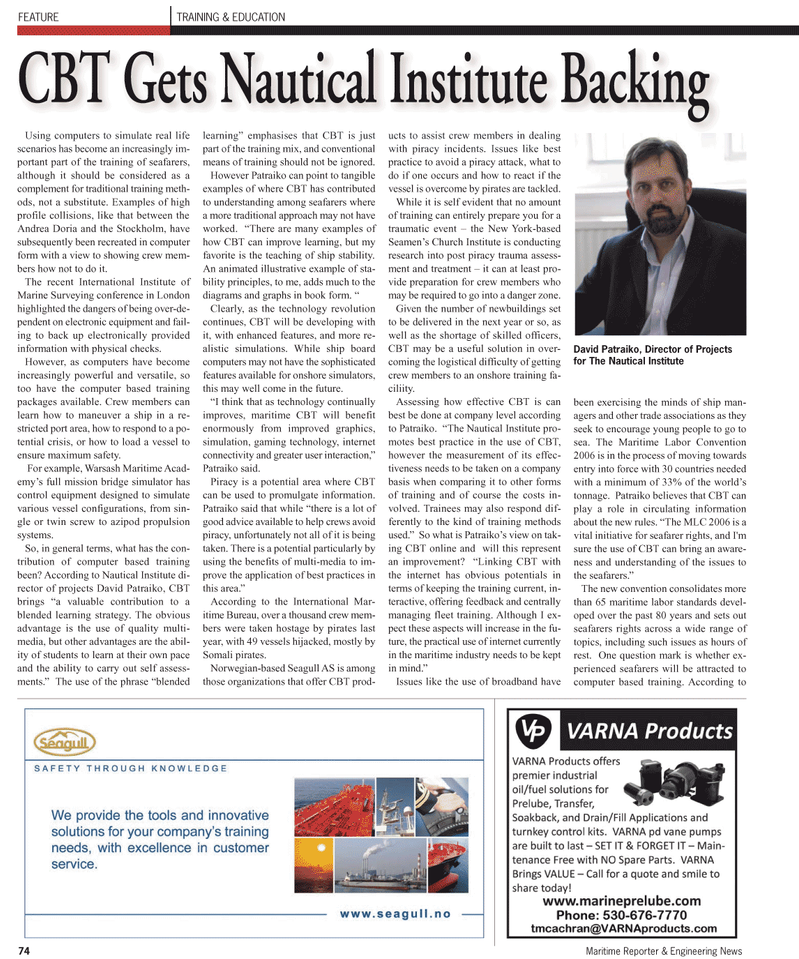
Page 76: of Maritime Reporter Magazine (November 2010)
Workboat Annual
Read this page in Pdf, Flash or Html5 edition of November 2010 Maritime Reporter Magazine
74 Maritime Reporter & Engineering News
TRAINING & EDUCATIONFEATURE
CBT Gets Nautical Institute Backing
Using computers to simulate real life scenarios has become an increasingly im- portant part of the training of seafarers, although it should be considered as a complement for traditional training meth- ods, not a substitute. Examples of high profile collisions, like that between the
Andrea Doria and the Stockholm, have subsequently been recreated in computer form with a view to showing crew mem- bers how not to do it.
The recent International Institute of
Marine Surveying conference in London highlighted the dangers of being over-de- pendent on electronic equipment and fail- ing to back up electronically provided information with physical checks.
However, as computers have become increasingly powerful and versatile, so too have the computer based training packages available. Crew members can learn how to maneuver a ship in a re- stricted port area, how to respond to a po- tential crisis, or how to load a vessel to ensure maximum safety.
For example, Warsash Maritime Acad- emy’s full mission bridge simulator has control equipment designed to simulate various vessel configurations, from sin- gle or twin screw to azipod propulsion systems.
So, in general terms, what has the con- tribution of computer based training been? According to Nautical Institute di- rector of projects David Patraiko, CBT brings “a valuable contribution to a blended learning strategy. The obvious advantage is the use of quality multi- media, but other advantages are the abil- ity of students to learn at their own pace and the ability to carry out self assess- ments.” The use of the phrase “blended learning” emphasises that CBT is just part of the training mix, and conventional means of training should not be ignored.
However Patraiko can point to tangible examples of where CBT has contributed to understanding among seafarers where a more traditional approach may not have worked. “There are many examples of how CBT can improve learning, but my favorite is the teaching of ship stability.
An animated illustrative example of sta- bility principles, to me, adds much to the diagrams and graphs in book form. “
Clearly, as the technology revolution continues, CBT will be developing with it, with enhanced features, and more re- alistic simulations. While ship board computers may not have the sophisticated features available for onshore simulators, this may well come in the future. “I think that as technology continually improves, maritime CBT will benefit enormously from improved graphics, simulation, gaming technology, internet connectivity and greater user interaction,”
Patraiko said.
Piracy is a potential area where CBT can be used to promulgate information.
Patraiko said that while “there is a lot of good advice available to help crews avoid piracy, unfortunately not all of it is being taken. There is a potential particularly by using the benefits of multi-media to im- prove the application of best practices in this area.”
According to the International Mar- itime Bureau, over a thousand crew mem- bers were taken hostage by pirates last year, with 49 vessels hijacked, mostly by
Somali pirates.
Norwegian-based Seagull AS is among those organizations that offer CBT prod- ucts to assist crew members in dealing with piracy incidents. Issues like best practice to avoid a piracy attack, what to do if one occurs and how to react if the vessel is overcome by pirates are tackled.
While it is self evident that no amount of training can entirely prepare you for a traumatic event – the New York-based
Seamen’s Church Institute is conducting research into post piracy trauma assess- ment and treatment – it can at least pro- vide preparation for crew members who may be required to go into a danger zone.
Given the number of newbuildings set to be delivered in the next year or so, as well as the shortage of skilled officers,
CBT may be a useful solution in over- coming the logistical difficulty of getting crew members to an onshore training fa- ciliity.
Assessing how effective CBT is can best be done at company level according to Patraiko. “The Nautical Institute pro- motes best practice in the use of CBT, however the measurement of its effec- tiveness needs to be taken on a company basis when comparing it to other forms of training and of course the costs in- volved. Trainees may also respond dif- ferently to the kind of training methods used.” So what is Patraiko’s view on tak- ing CBT online and will this represent an improvement? “Linking CBT with the internet has obvious potentials in terms of keeping the training current, in- teractive, offering feedback and centrally managing fleet training. Although I ex- pect these aspects will increase in the fu- ture, the practical use of internet currently in the maritime industry needs to be kept in mind.”
Issues like the use of broadband have been exercising the minds of ship man- agers and other trade associations as they seek to encourage young people to go to sea. The Maritime Labor Convention 2006 is in the process of moving towards entry into force with 30 countries needed with a minimum of 33% of the world’s tonnage. Patraiko believes that CBT can play a role in circulating information about the new rules. “The MLC 2006 is a vital initiative for seafarer rights, and I'm sure the use of CBT can bring an aware- ness and understanding of the issues to the seafarers.”
The new convention consolidates more than 65 maritime labor standards devel- oped over the past 80 years and sets out seafarers rights across a wide range of topics, including such issues as hours of rest. One question mark is whether ex- perienced seafarers will be attracted to computer based training. According to
David Patraiko, Director of Projects for The Nautical Institute

 75
75

 77
77
